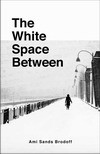
The White Space Between
Ami Sands Brodoff
Second Story Press
$18.95
paper
318pp
978-1-897187-49-4
A similar photo album takes centre stage in Ami Sands Brodoff’s The White Space Between, a gentle, artful story that weaves together the past and present as Willow, the main character, tries to fill in the gaps in her life story; gaps originating with those relatives lost in the Holocaust.
As a child of a Holocaust survivor, Willow’s life is marked by the scars her mother, Jana, bears. Typically survivors steer clear of reliving painful memories, and Jana is no exception. Wanting her daughter to have only good memories, Jana collected what photos she could of the family and every night told her daughter stories to go with the pictures. Although there’s an element of falsity for Willow, since her life history had been created second-hand and not out of personal experience, Willow is still comforted by these memories.
She remembers pain, but holding the memory books, her mother shimmers and glows, the comforting weight across their laps makes them both feel safe, and loosens her mother’s tongue. Willow savors the magic of each individual scene, fixed in time, anchored in space, and if she imagines herself inside, she can walk right into each photograph, and make everything come out all right in the end.
Willow follows in her grandfather’s artistic footsteps by becoming a puppeteer, creating a world that exists outside the white spaces of the photographs in her mother’s albums. In a powerful act of imagination, Willow creates marionettes that become a family to her. Through them she creates stories that give structure and meaning to her life. They also serve as a Greek chorus on her journey to find the part of her life that her mother gives only the barest of details about – the part where her father is concerned.
Although Willow was born in New Jersey, Jana spent many years after World War II in Montreal, and it is to this city that Willow is drawn. Single and in her late 30s, she has been invited to Usine C as the artist-in-residence, giving workshops and performances.
Those who know Montreal well will feel right at home as Willow discovers fripperies, the chalet on the mountain, fresh bagels, and smoked meat. Willow’s senses are stirred on many levels, and piece by piece she creates a place in which to grow beyond the memory books of her childhood.
“Although we take stories of childhood and family literally,” writes Annette Kuhn in Family Secrets: Acts of Memory and Imagination, a book about stories that live beyond the edges of photographs, “I think our recourse to this past is a way of reaching for myth, for the story that is deep enough to express the profound feelings we have in the present.”
Experiences sometimes rob people of the words to express themselves, yet those silent places often affect us most deeply. In The White Space Between, Brodoff allows art to speak the unspeakable softly. Ultimately, she weaves myth and reality into an honest story where the white spaces are a balm for the woes and wounds of the stories that shape us. mRb






0 Comments